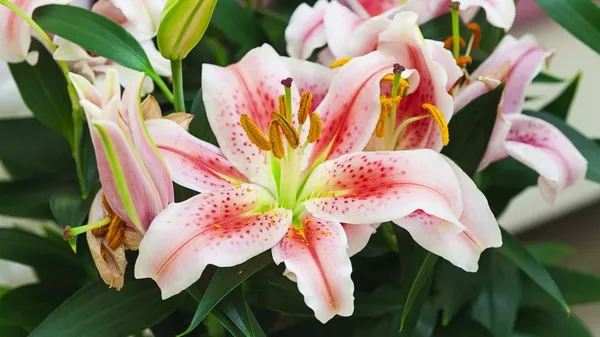Flowers have been an integral part of human culture for centuries, symbolizing emotions, seasons, and celebrations. The concept of assigning specific flowers to each month has a rich history, intertwining folklore, mythology, and cultural traditions.
January – Carnations
As the first month of the year, January is associated with fresh beginnings and resolutions. The birth flower of January is the carnation. Known for its vibrant hues and ruffled petals, the carnation symbolizes love, fascination, and distinction. In various cultures, carnations are also linked to good luck and admiration. Whether displayed in a bouquet or worn as a boutonniere, these flowers are a fitting choice to kick off the year with positivity and charm.
February – Violets
As the month of love and romance, February is adorned with the delicate beauty of violets. These petite and enchanting flowers are associated with deep affection and faithfulness. In Roman mythology, violets are linked to Venus, the goddess of love. Their rich purple and blue hues convey sentiments of loyalty, making them a perfect choice for expressing heartfelt emotions during the month of Valentine’s Day.
March – Daffodils
Welcoming the arrival of spring, March is characterized by the emergence of vibrant daffodils. These cheerful yellow blossoms are emblematic of renewal and the promise of warmer days ahead. Daffodils symbolize hope and new beginnings, making them a fitting choice for the month that marks the end of winter. In various cultures, daffodils are also associated with prosperity and good fortune.
April – Daisies
April showers bring forth an abundance of daisies. With their simple yet captivating charm, daisies represent innocence, purity, and loyal love. These flowers are often used to convey sentiments of friendship and are a popular choice for spring weddings. Their white petals and golden centers evoke the essence of a fresh start, making them an ideal bloom for the blossoming season.
May – Lily of the Valley
May, with its lush greenery and blooming landscapes, is represented by the delicate and fragrant lily of the valley. These bell-shaped flowers symbolize sweetness, humility, and a return to happiness. In Victorian times, lily of the valley was often chosen for bridal bouquets, signifying the return of happiness for the newlyweds. The enchanting fragrance of these flowers adds an extra layer of appeal to their timeless beauty.
June – Roses
June, synonymous with weddings and romance, features the timeless elegance of roses. These classic flowers are universally recognized as symbols of love and passion. Each color of rose carries its own significance, with red representing deep love, white symbolizing purity, and yellow conveying friendship. Roses are a staple in bridal bouquets and are often exchanged as tokens of affection on special occasions.
July – Larkspurs
July brings forth the bold and vibrant hues of larkspurs. These tall and stately flowers are associated with strong bonds of love and positivity. Larkspurs come in a variety of colors, each carrying its own symbolism. The blue larkspur is linked to grace and dignity, while the pink variety signifies fickleness. These flowers are a visual representation of the energy and warmth of summer.
August – Gladiolus
Representing strength, moral integrity, and infatuation, the gladiolus takes center stage in August. These tall and striking flowers are known for their impressive spikes of blossoms, making them a symbol of strength of character. The name “gladiolus” is derived from the Latin word “gladius,” meaning sword, emphasizing the association with strength and resilience. Gladiolus are often used to convey admiration and sincerity.
September – Aster
As the days begin to cool and autumn approaches, the aster graces the month of September. These star-like flowers symbolize love, wisdom, and faith. In ancient times, asters were believed to possess magical properties, and their name is derived from the Greek word for star. With their vibrant colors and intricate blossoms, asters bring a touch of celestial beauty to the fall landscape.
October – Marigolds
In October, the landscape is adorned with the warm and fiery hues of marigolds. These bold flowers symbolize passion, creativity, and positive energy. In various cultures, marigolds are associated with celebrations and festivals, often used to create vibrant garlands and decorations. The rich orange and gold tones of marigolds evoke the essence of autumn, making them a perfect choice for October.
November – Chrysanthemums
As the days grow shorter and colder, November introduces the regal beauty of chrysanthemums. These flowers, often
referred to as “mums,” symbolize loyalty, love, and longevity. In many cultures, chrysanthemums are associated with honoring the deceased and are commonly used in funeral arrangements. Their diverse colors and intricate petal arrangements make them a versatile and meaningful choice for the month of remembrance.
December – Holly
December, synonymous with festive celebrations and winter landscapes, features the vibrant red berries and glossy green leaves of holly. While not a traditional bloom, holly is a quintessential part of December decorations. Symbolizing goodwill and peace, holly is often used in wreaths and festive arrangements. The sharp contrast between the red berries and green leaves adds a festive touch to holiday décor.
Conclusion
In the tapestry of nature’s calendar, each month unfolds with its own unique set of flowers, symbolizing the essence of that particular time of year. Whether expressing love, renewal, or remembrance, these flowers have woven themselves into the cultural fabric of societies around the world. Understanding the symbolism and significance behind the flowers of the month adds an extra layer of appreciation to these natural wonders, allowing us to connect with the rich traditions and sentiments they carry throughout the year.


